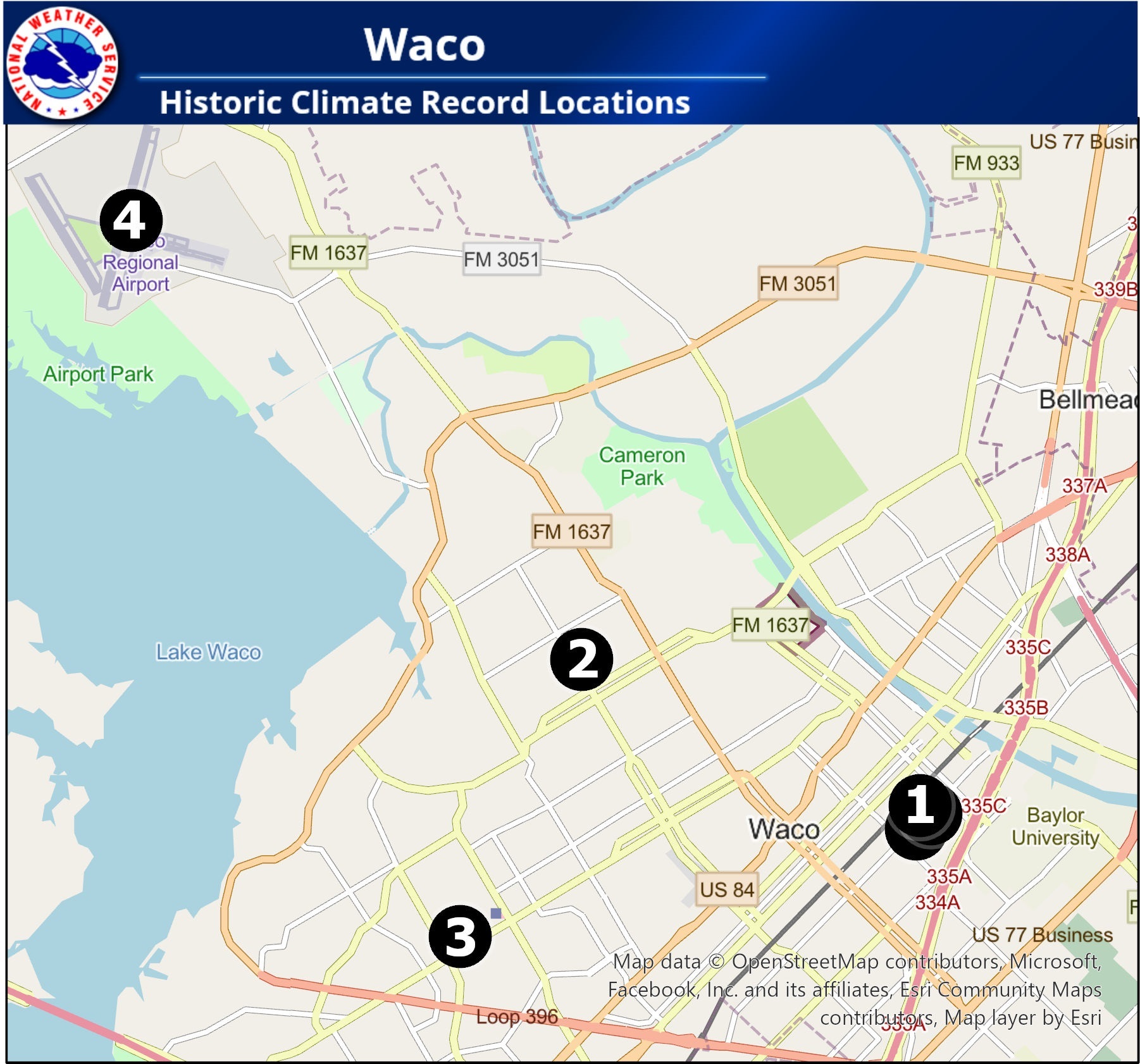
An atmospheric river will bring heavy rainfall to lower elevations of California this week, and heavy snow to the Sierra Nevada mountains. Flash flooding, some of which may be locally considerable, will be a concern on the western foothills of the Sierra Nevada mountains through Tuesday. Landslides, rockfalls and mudslides are possible in the Southern California mountains. Read More >
The Climate of Waco
Waco is located in the Brazos Valley of Central Texas. Named for the Hueco tribe that previously inhabited the area, the European settlement of Waco was established in 1849. Cooperative observer data began in 1901, eventually being replaced by observations from the municipal airport in 1940.
Near the southern extent of the Great Plains, Waco lies within the Texas Blackland Prairie. Urbanization and agriculture have changed the landscape, but grasslands and stands of oaks remain. The Brazos River flows through the city, its fertile valley bordered by rolling hills. Tributaries to the west feed Lake Waco, the city’s water supply, which is immediately adjacent to the airfield. Prevailing southerly winds come off the lake, at times producing mircoclimatic effects at the airport that are not experienced in the city, which lies east of the lake. The Brazos River spills into the Gulf of America, over 200 miles to the southeast.
The climate of Waco is humid subtropical with hot summers. It is also continental, characterized by a wide annual temperature range. Precipitation varies considerably, annual values ranging from less than 20 inches to more than 50 inches. The precipitation is also unevenly distributed throughout the year, typically favoring a bimodal distribution of wet spring/fall and dry summer/winter. Although the average freeze-free period runs from March to November, the actual growing seasons are more closely tied to the rainier periods of spring and fall, with dormancy dominating summer and winter.
Winters are generally mild, but the season features considerable temperature variability. Periodic cold fronts bring usually brief spells of below normal temperatures. A warming trend usually follows a bout of cold weather, typically culminating before the next cold front arrives. Being both outlying and low-lying, the airport captures the enhanced cooling that occurs within the Brazos River Valley on the coldest winter nights. Although winter is the cloudiest season, less precipitation occurs than during the adjacent seasons of fall and spring. Brief precipitation often accompanies frontal passages, but more prolonged periods of rain and drizzle can occur when cold air is in place. Wintry precipitation is infrequent, and measurable snowfall only occurs about every other winter.
Maritime tropical air masses are difficult to dislodge during the summer, and temperatures vary little as a result. During the peak summer months of July and August, also the sunniest months of the year, daytime temperatures are consistently in the 90s, often reaching or exceeding 100 degrees. Gulf moisture maintains stifling humidity, and overnight temperatures occasionally fail to fall below 80 degrees. Brief afternoon or evening thunderstorms account for the bulk of the limited rainfall during the summer, usually occurring on days that are otherwise sunny and hot. Impacts from tropical systems are quite infrequent and generally limited to unusually cloudy/rainy periods.
The transition seasons of spring and fall are typically the wettest periods of the year, but the bulk of the rainfall is associated with thunderstorms, and extended periods of pleasant weather still occur. The frequency of thunderstorms and associated severe weather peaks during the spring. Large hail, damaging winds, flooding, and tornadoes occur nearly every year in Central Texas, but Waco is unlikely to experience all of these events every year.
While the climate record for Waco is considered continuous, data are from the following locations:
| 1 | 1901-1934 | Downtown Waco (3 separate locations) |
| 2 | 1934-1940 | North Waco |
| 3 | 1940-1943 | Rich Field |
| 4 | 1943-present | Blackland Field (1943-1951) Waco Municipal Airport (1951-1973) Madison Cooper Airport (1973-1993) Waco Regional Airport (1993-present) |
